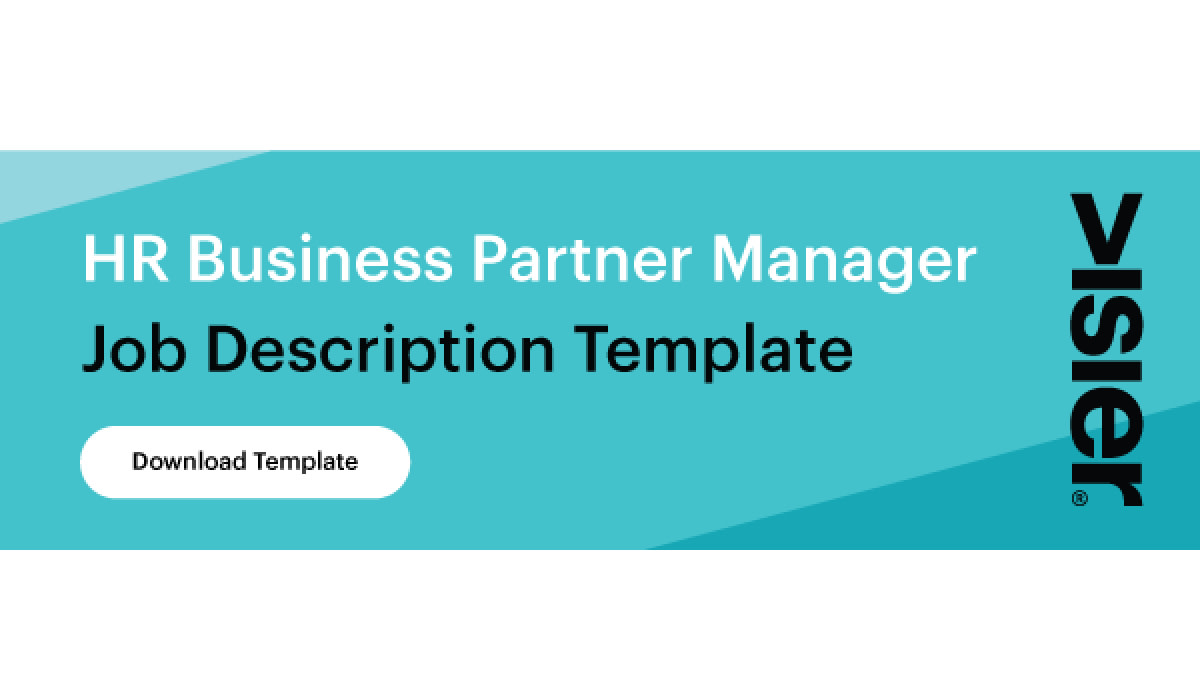Secure the Right HR Business Partner Manager for the Future
Whether you level up the skills of an existing HR business partner Manager or hire outside your organization, here are the responsibilities of this role.

Last week, I shared the job description for the People Analytics Leader (you can download the job description template for your use here). This week, I do the same for the strategic and data-driven HR Business Partner Manager (template available here).
Many organizations have done HR transformation work and evolved their administrative HR staff into strategic HR business partners. However, today there is controversy about whether these HR business partners (HRBPs) are truly strategic.
In my forthcoming research, I spoke with numerous organizations that reported less than 25% of their HRBPs understood the businesses they support. Instead of providing strategic insight, many HRBPs still operate more as administrative aides to the business and prefer to handle employee relations problems.
Furthermore, the HR leaders I interviewed said that only between 10-25% of their HRBPs are analytical; yet, these HRBPs are being asked to bring analytics to the rest of the business and promote a data-driven culture. In this recent People Analytics survey, we reported that only 22% of all respondents see the HR Business Partner as an effective champion to promote use of people analytics.
There is clearly a need here to transform, augment, or significantly develop, the role of the HRBP.
At one organization, for example, they have conducted a gap analysis to determine which HRBPs have the skills, who they need to develop, and even who they need to wipe the slate clean and look outside for the skills needed.
The key to transforming the role of HRBPs is putting the right HRBP Manager in charge of this team. One who, in addition to having responsibilities for the HR aspects of their job, is successful at enabling people analytics within their organizations.

This manager (or director even) is likely within HR Services or HR Operations and sits either at a corporate or country-level. They may even be in charge of a global HR Service Center. Whether you level up the skills of an existing HRBP Manager or hire outside your organization, here are the responsibilities of this crucial role:
Link the business strategy with talent strategy
These managers understand both the business and talent strategies of their organization, but also how to communicate the talent strategy in the language of the business and vice versa. They further can work with their HRBPs to develop this mindset as well. They drive the enterprise-wide talent agenda through the people managers they collectively serve.
For example, at a major healthcare organization–that has undergone an enterprise-wide upskilling on people analytics–the HRBPs partner with hospital leaders to achieve business outcomes, often around achieving HCAHPS goals and using people analytics to provide counseling.
Not only does the HRBP Manager know how to manage business risk (related to employee tenure, sentiment, engagement, succession, readiness to change, etc.), they and the HRBPs they manage can also find the right talent interventions, based on data, to address these risks. One HRBP from a highly distributed organization with operations across multiple countries says:
“I connect people strategy to business outcomes with data from our people analytics. I mine the data to bring to our meetings. I bring a set of metrics and show each leader how they compare to others and from this we can explore risks and opportunities.”
Open to both using and becoming a champion of people analytics
Those tapped to be evangelists of people analytics have learned how to use this technology themselves. Like the People Analytics Leader, these HRBP Managers live and breathe the mantra that the reason for people analytics is to provide business outcome value.
As such, they have learned how to champion people analytics to their HRBPs and their business leaders, a key part of their role that may require them to also be change management specialists.
“We needed to be trained on what questions to ask to help our business leaders get to the root cause on issues,” said an HRBP manager in an organization with a major change management initiative targeted at transforming the HRBPs to be more analytical.
Use analytics to become a “data-driven” strategic HR business partner
As mentioned, strategic HRBP managers are able to leverage people data and insights to drive business actions. They help create solutions and best practices for uncovering data-driven insights to better attract, develop, motivate, and retain their organization’s most valuable asset–it’s people.
HRBP Managers are able to diagnose business needs, identify areas for improvement, and leverage data to help their strategic HRBPs in turn support their organization’s leaders to achieve their goals. One key skill they have is the ability to identify the right questions to be answered with people analytics. They ask questions such as do we have enough people to open a new distribution center? How can I lower labor costs? How can I reduce overtime costs? Why am I losing people?
In all these questions, they are able to elevate the discussion so it’s driven by data. For example, some use a scorecard on people costs to look at comparative turnover, or look at employee movement throughout the organization.
Says one HRBP at a major healthcare organization: “I see the use of data as always in support of having conversations with my business leaders. I suggest questions, show how they can be answered with data, and thereby help our leaders not only think through their issues but in turn begin to explore using the data themselves.”
Apply analytics to improve talent processes
Using people analytics should not just be about improving HR’s processes for HR’s sake. This ability to apply analytics to HR process improvement work helps develop and refine talent processes to make an exceptional workplace even better. Thus, HRBP Managers focus on using data in support of organizational talent activities such as succession planning and career development–not processes like conducting performance reviews and ensuring they are completed on time.
In a global manufacturing organization, the head of HR service delivery, responsible for multiple HRBPs reports:
“With data to support our insights, we truly have the seat at the table we’ve long aspired to with our contributions to strategic workforce planning and global talent acquisition support.”
Stimulate their HRBPs to work collaboratively to use and promote people analytics
HRBP Managers understand how to sponsor the right analytics project. They don’t just look at turnover metrics and say there’s a problem.
They go deeper into the data and seek answers to questions such as what are the resignation drivers in the group with the highest turnover? What characteristics do our most productive employees share? Do hiring more college graduates or training internally lead to better business outcomes? What gaps do we have in our diversity initiatives? Are we utilizing our millennials effectively, understanding the skills they bring to the organization?
Here’s what an HRBP at a tri-state healthcare organization does:
“We encourage our HRBPs to partner with each other, as otherwise, people analytics gets overwhelming. We give everyone an assignment and encourage them to use each other as a sounding board to discuss the insights. We looked at over 150 of our business units and determined the ones we should focus on to improve employee and customer experience recently. To be honest, sometimes we go back to the analytics team who help us boil the ocean and further refine findings.”
Learn to tell a story with data
The best HRBP Managers know how to tell a story with people analytics and can encourage their team of HRBPs to do the same. Stories shouldn’t just show numbers and charts on a page, but make the information flow in such a way that it makes stakeholders zoom into where action needs to be taken. For more on telling a story with data, please see this post by Max Bitel or this one by Dr. John Boudreau.
Whether you are looking to hire or become a data-driven and strategic HRBP Manager for your organization, I encourage you to download this job description! Also, here’s a analytics-focused roles and responsibilities article for the CHRO.
Let me know if I’m missing anything in these job descriptions on Twitter by tagging @Visier and @lexymartin in your posts!
Get the Outsmart newsletter
You can unsubscribe at any time. For more information, check out Visier's Privacy Statement.


